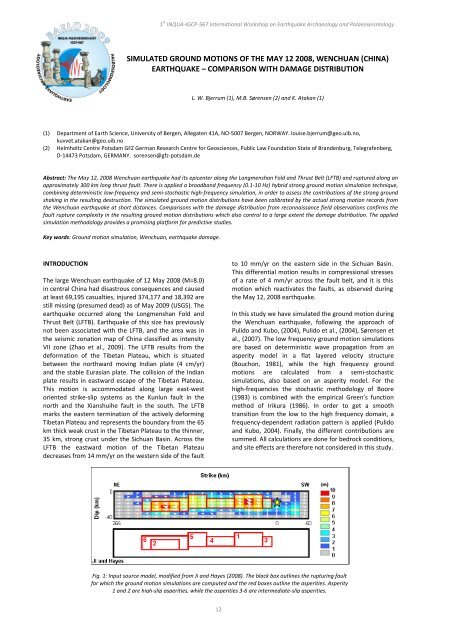Archaeoseismology and Palaeoseismology in the Alpine ... - Tierra
Archaeoseismology and Palaeoseismology in the Alpine ... - Tierra
Archaeoseismology and Palaeoseismology in the Alpine ... - Tierra
You also want an ePaper? Increase the reach of your titles
YUMPU automatically turns print PDFs into web optimized ePapers that Google loves.
1 st INQUA‐IGCP‐567 International Workshop on Earthquake Archaeology <strong>and</strong> <strong>Palaeoseismology</strong><br />
SIMULATED GROUND MOTIONS OF THE MAY 12 2008, WENCHUAN (CHINA)<br />
EARTHQUAKE – COMPARISON WITH DAMAGE DISTRIBUTION<br />
L. W. Bjerrum (1), M.B. Sørensen (2) <strong>and</strong> K. Atakan (1)<br />
(1) Department of Earth Science, University of Bergen, Allegaten 41A, NO‐5007 Bergen, NORWAY. louise.bjerrum@geo.uib.no,<br />
kuvvet.atakan@geo.uib.no<br />
(2) Helmholtz Centre Potsdam GFZ German Research Centre for Geosciences, Public Law Foundation State of Br<strong>and</strong>enburg, Telegrafenberg,<br />
D‐14473 Potsdam, GERMANY. sorensen@gfz‐potsdam.de<br />
Abstract: The May 12, 2008 Wenchuan earthquake had its epicenter along <strong>the</strong> Longmenshan Fold <strong>and</strong> Thrust Belt (LFTB) <strong>and</strong> ruptured along an<br />
approximately 300 km long thrust fault. There is applied a broadb<strong>and</strong> frequency (0.1‐10 Hz) hybrid strong ground motion simulation technique,<br />
comb<strong>in</strong><strong>in</strong>g determ<strong>in</strong>istic low‐frequency <strong>and</strong> semi‐stochastic high‐frequency simulation, <strong>in</strong> order to assess <strong>the</strong> contributions of <strong>the</strong> strong ground<br />
shak<strong>in</strong>g <strong>in</strong> <strong>the</strong> result<strong>in</strong>g destruction. The simulated ground motion distributions have been calibrated by <strong>the</strong> actual strong motion records from<br />
<strong>the</strong> Wenchuan earthquake at short distances. Comparisons with <strong>the</strong> damage distribution from reconnaissance field observations confirms <strong>the</strong><br />
fault rupture complexity <strong>in</strong> <strong>the</strong> result<strong>in</strong>g ground motion distributions which also control to a large extent <strong>the</strong> damage distribution. The applied<br />
simulation methodology provides a promis<strong>in</strong>g platform for predictive studies.<br />
Key words: Ground motion simulation, Wenchuan, earthquake damage.<br />
INTRODUCTION<br />
The large Wenchuan earthquake of 12 May 2008 (M=8.0)<br />
<strong>in</strong> central Ch<strong>in</strong>a had disastrous consequences <strong>and</strong> caused<br />
at least 69,195 casualties, <strong>in</strong>jured 374,177 <strong>and</strong> 18,392 are<br />
still miss<strong>in</strong>g (presumed dead) as of May 2009 (USGS). The<br />
earthquake occurred along <strong>the</strong> Longmenshan Fold <strong>and</strong><br />
Thrust Belt (LFTB). Earthquake of this size has previously<br />
not been associated with <strong>the</strong> LFTB, <strong>and</strong> <strong>the</strong> area was <strong>in</strong><br />
<strong>the</strong> seismic zonation map of Ch<strong>in</strong>a classified as <strong>in</strong>tensity<br />
VII zone (Zhao et al., 2009). The LFTB results from <strong>the</strong><br />
deformation of <strong>the</strong> Tibetan Plateau, which is situated<br />
between <strong>the</strong> northward mov<strong>in</strong>g Indian plate (4 cm/yr)<br />
<strong>and</strong> <strong>the</strong> stable Eurasian plate. The collision of <strong>the</strong> Indian<br />
plate results <strong>in</strong> eastward escape of <strong>the</strong> Tibetan Plateau.<br />
This motion is accommodated along large east‐west<br />
oriented strike‐slip systems as <strong>the</strong> Kunlun fault <strong>in</strong> <strong>the</strong><br />
north <strong>and</strong> <strong>the</strong> Xianshuihe fault <strong>in</strong> <strong>the</strong> south. The LFTB<br />
marks <strong>the</strong> eastern term<strong>in</strong>ation of <strong>the</strong> actively deform<strong>in</strong>g<br />
Tibetan Plateau <strong>and</strong> represents <strong>the</strong> boundary from <strong>the</strong> 65<br />
km thick weak crust <strong>in</strong> <strong>the</strong> Tibetan Plateau to <strong>the</strong> th<strong>in</strong>ner,<br />
35 km, strong crust under <strong>the</strong> Sichuan Bas<strong>in</strong>. Across <strong>the</strong><br />
LFTB <strong>the</strong> eastward motion of <strong>the</strong> Tibetan Plateau<br />
decreases from 14 mm/yr on <strong>the</strong> western side of <strong>the</strong> fault<br />
12<br />
to 10 mm/yr on <strong>the</strong> eastern side <strong>in</strong> <strong>the</strong> Sichuan Bas<strong>in</strong>.<br />
This differential motion results <strong>in</strong> compressional stresses<br />
of a rate of 4 mm/yr across <strong>the</strong> fault belt, <strong>and</strong> it is this<br />
motion which reactivates <strong>the</strong> faults, as observed dur<strong>in</strong>g<br />
<strong>the</strong> May 12, 2008 earthquake.<br />
In this study we have simulated <strong>the</strong> ground motion dur<strong>in</strong>g<br />
<strong>the</strong> Wenchuan earthquake, follow<strong>in</strong>g <strong>the</strong> approach of<br />
Pulido <strong>and</strong> Kubo, (2004), Pulido et al., (2004), Sørensen et<br />
al., (2007). The low frequency ground motion simulations<br />
are based on determ<strong>in</strong>istic wave propagation from an<br />
asperity model <strong>in</strong> a flat layered velocity structure<br />
(Bouchon, 1981), while <strong>the</strong> high frequency ground<br />
motions are calculated from a semi‐stochastic<br />
simulations, also based on an asperity model. For <strong>the</strong><br />
high‐frequencies <strong>the</strong> stochastic methodology of Boore<br />
(1983) is comb<strong>in</strong>ed with <strong>the</strong> empirical Green’s function<br />
method of Irikura (1986). In order to get a smooth<br />
transition from <strong>the</strong> low to <strong>the</strong> high frequency doma<strong>in</strong>, a<br />
frequency‐dependent radiation pattern is applied (Pulido<br />
<strong>and</strong> Kubo, 2004). F<strong>in</strong>ally, <strong>the</strong> different contributions are<br />
summed. All calculations are done for bedrock conditions,<br />
<strong>and</strong> site effects are <strong>the</strong>refore not considered <strong>in</strong> this study.<br />
Fig. 1: Input source model, modified from Ji <strong>and</strong> Hayes (2008). The black box outl<strong>in</strong>es <strong>the</strong> ruptur<strong>in</strong>g fault<br />
for which <strong>the</strong> ground motion simulations are computed <strong>and</strong> <strong>the</strong> red boxes outl<strong>in</strong>e <strong>the</strong> asperities. Asperity<br />
1 <strong>and</strong> 2 are high‐slip asperities, while <strong>the</strong> asperities 3‐6 are <strong>in</strong>termediate‐slip asperities.



